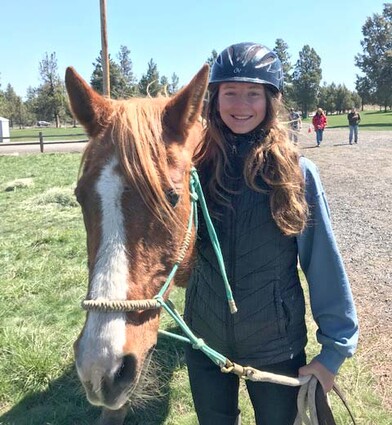Sisters hosts endurance boot camp
Last updated 4/30/2019 at Noon
The grassy field of the Sisters Rodeo Grounds was full of horses, camping trailers, and excited riders on Saturday, April 27, for the beginning of the Sisters Endurance Boot Camp. In this boot camp, horses and riders learned the basics of endurance riding, tips on how to be more a efficient trail rider, and endurance riding horse care.
The first event of the boot camp was learning how to do a vet check, led by Dr. Kelly Jones. A vet check consists of a veterinarian evaluating the condition that the horse is in by checking its heart rate, gait, level of hydration and gut sounds. The vet check is important because it lets the rider know if her/his horse is fit and healthy enough to compete or go on with the race.
Riders learned how to make sure their horse stands still while the vet evaluates it, and the importance of making sure that the horse is comfortable with the stethoscope. Dr. Jones identified two horses that were not fit to compete due to lameness issues, so they were “pulled” — a good thing for the horse but a big letdown for the excited rider.
Next on the endurance ride boot camp agenda was a seminar in which many speakers shared their strategies, “hacks,” and experiences with endurance riding.
One of the subjects discussed was proper hoof protection, shared by farriers Kyle Hockett and Wendy Hutchens. They talked about using boots vs. shoes for endurance riding, and the pros and cons of either decision (shoes are nailed to the bottom the hoof, and are put on and taken off by a farrier, while boots can be put on and taken off at any point by the rider because they are not nailed on to the hoof).
They also displayed and passed around a series of boots used in past rides, showing which were the best types to purchase.
Another subject was how to efficiently pack the essentials the riders would take to a ride, presented by Bianca Chevalier. Some of the things mentioned were the proper saddle bags to use; a small but effective first aid kit; horse treats; a collapsible water bucket; water bottle or hydration backpack and many more.
Proper ride nutrition for horses was another important lesson, shared by Marlene Moss and Tally Wren. The main points of this part of the seminar highlighted proper pre-, during, and post-ride nutrition of the horse. For example, flaxseed consists of a lot of fat, which is OK to feed at home, but not during a ride. Beet pulp, on the other hand, is a good ride food because it’s highly digestible, helping hydrate the horse. Other seminar subjects were tack, how horses think, conditioning, and horse health.
After the seminar, riders and guests gathered for a chilly community potluck sharing stories while getting to know one another.
Next, the details of Sunday’s mock endurance ride were presented. This practice endurance ride would be an opportunity for riders to exercise their newly learned skills and for new riders to see if they like the sport.
The practice competition consisted of two distances that riders could choose between. One was a four-mile loop and the second was an eight-mile loop. Riders picked their distances by the level of condition their horse was in and their level of comfort out on the trails. The ride was conducted on the immaculate Peterson Ridge equestrian trails maintained by the Sisters Trails Alliance.
On Sunday at 9 a.m., horses and riders lined up on the starting line on the outskirts of camp to begin their race. The ride would go on until after 11 a.m. with participants applying the skills and tips that they had gotten during the clinic. The four-mile riders followed yellow ribbons marking the trail, while the eight-mile riders followed a combination of yellow ribbons and then blue. At the end of the ride, riders were required to bring their horses through a second vet check to assure that their horses were still good to go. Awards were given for the best-conditioned horse and the horse that was most well-behaved during the vet check.
The riders participating in this event came from all over the Northwest, with one person from California, but most were Central Oregon locals. The riders’ skill levels ranged from highly experienced endurance riders wanting to tune up their skills to beginners attending their first endurance event. Two riders, Riki Merrick and Rebecca Barth-Aasen, participated in this event in memory of their friend Ed Helton who had influenced many in Central Oregon to start riding the trails. According to boot camp organizer, Jeff Tryens, Ed’s interest in learning about endurance riding had inspired Jeff to hold this first-ever endurance clinic in
Sisters.
When boot camp wrapped up on Sunday at noon, participants left with big smiles on their faces and a bag full of tips to help them become better endurance riders.
Editor’s note: The author of this article, Sister High School junior Sasha Komar, participated in the clinic, finishing the ride portion well ahead of the rest of the pack on her horse, Ali.

















Reader Comments(0)